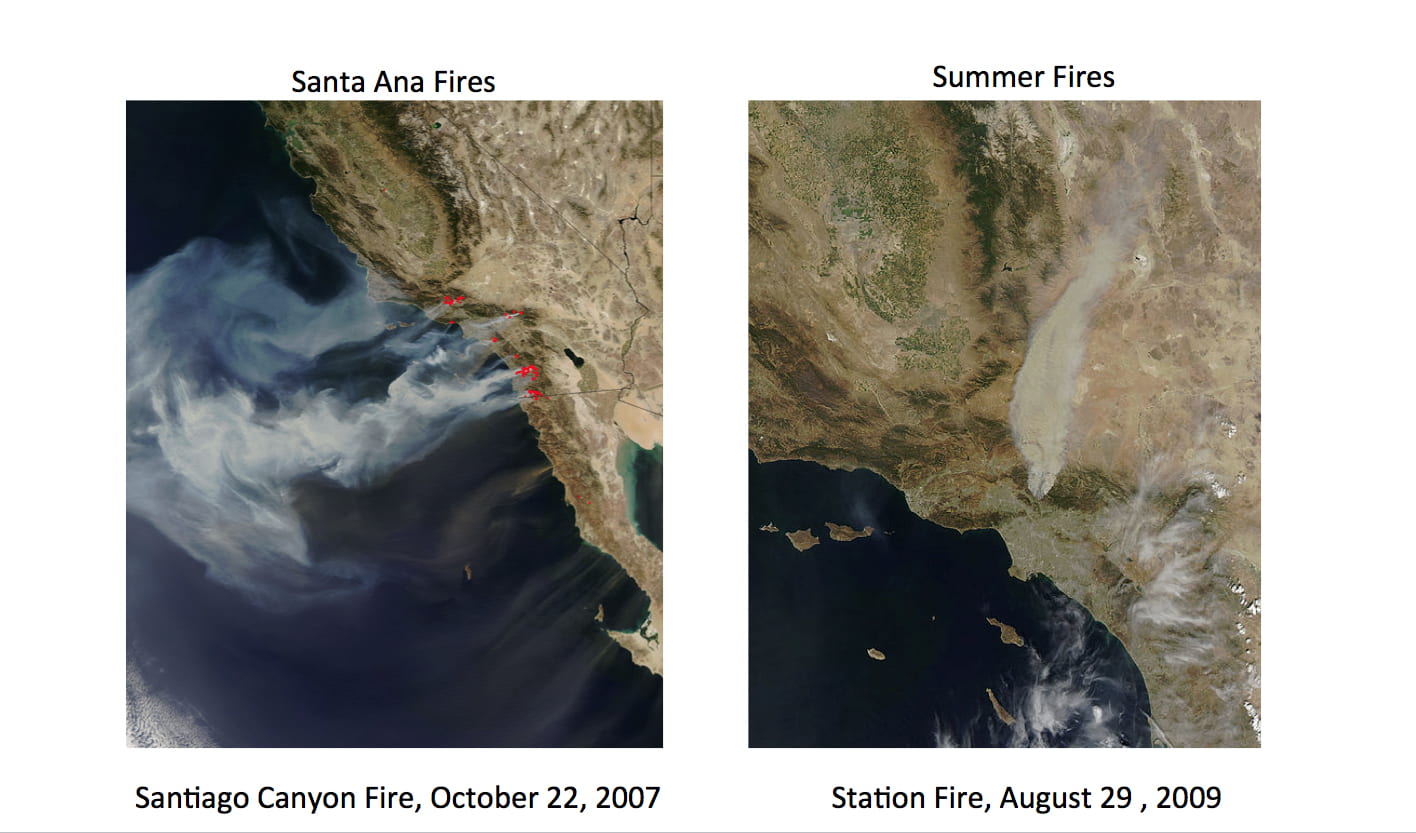Southern California wildfires exhibit split personalities
UCI, other researchers examine differences between summer, Santa Ana fires

Irvine, Calif., Sept. 8, 2015 – Wildfires have ravaged both populated and unpopulated regions of Southern California at an increasing rate over the past few decades, and scientists from three University of California campuses and partner institutions are predicting that by midcentury, as a consequence of climate change causing hotter and drier summers, a lot more will go up in flames.
In a paper published today in the journal Environmental Research Letters, the scientists discuss the split-personality nature of Southern California wildfires. They describe two distinct wildfire types – those driven by offshore Santa Ana winds that kick up in the fall and those that result primarily from hot, dry conditions in the summer.
In terms of the amount of acreage consumed, the two fire types are roughly equal, but the Santa Ana fires, which tend to hit more developed areas, have been 10 times more costly over the period studied, 1990 to 2009. The researchers relied on NASA satellite data and decades’ worth of fire records from the California Department of Forestry and Fire Protection and the U.S. Forest Service.
“This research is coming at the right time, considering that California and western areas of the United States are expected to face increased fire risk in the near term from the current multiyear drought,” said lead author Yufang Jin, an assistant professor in the Department of Land, Air & Water Resources at UC Davis. Jin was a researcher at the University of California, Irvine when the study was conducted.
Stoked by dry desert air channeled through mountain passes and canyons, Santa Ana fires burn with more intensity, and they do their worst in a shorter period of time than do summer fires; in a typical Santa Ana fire, half the territory burned is consumed on the first day of the blaze. Well-known examples of Santa Ana fires include the costly Cedar Fire in San Diego in 2003, the Santiago fire near Irvine in 2007, and a devastating blaze that ravaged Laguna Beach in 1993.
Non-Santa Ana fires, by contrast, burn more slowly and tend to occur in more remote mountain areas. Non-Santa Ana fires, such as the Station Fire that scorched large portions of the Angeles National Forest in 2009, rely on hot temperatures and are more sensitive to the accumulation of woody debris and other dried out vegetation that serve as a fuel source.
Both types of fires are costly and damaging, but the researchers see change on the horizon. “We found that overall risk for Southern California increases for both types of fires, but we will become more vulnerable to the non-Santa-Ana types of fires,” said co-author Alex Hall, UCLA professor of atmospheric and oceanic studies. “This is a new way of seeing future fire risk in the region. Right now, the effect of the fall Santa Ana winds on fire leads to a strong sense of there being a ‘fire season.’ The future increase in the non-Santa Ana fires in the summer will make the fire season start much earlier.”
The researchers said that firefighting agencies at the local, state, and national levels should begin now to prepare for a future with more wildfires in Southern California and the rest of the western United States. In fact, one issue the researchers point to is the potential for more regional competition in summer for firefighting resources – air tankers, vehicles, and personnel.
The disproportionate impact of Santa Ana fires also has implications for optimizing resources. “The large economic and human impacts of Santa Ana fires raises the question of whether more resources during fall could be marshalled for suppressing these fires,” said James Randerson, Chancellor’s Professor of Earth system science at UCI and senior author on the paper.
UCLA’s Hall said climate change will have the biggest impact on the summer fire regime, though the fall fire regime will also be affected. “Warming in the summertime will be a big factor in increasing the number and size of non-Santa Ana fires. Lower relative humidity during Santa Ana events resulting from climate change toward the middle of the century will lead to larger Santa Ana fires,” he said.
“The traditional one-size-fits-all fuel management strategy will likely not be effective in reducing fire risks and preventing large fires,” said Jin. “Explicit consideration of local meteorology, extreme climate events, and ecosystem processes, provides a blueprint for developing effective mitigation and adaptation strategies and for designing improved fire projections in California and other regions.”
This work was supported by research grants to the University of California, NASA’s Jet Propulsion Laboratory, and the Jenkins Family Foundation.
About the University of California, Irvine: Currently celebrating its 50th anniversary, UCI is the youngest member of the prestigious Association of American Universities. The campus has produced three Nobel laureates and is known for its academic achievement, premier research, innovation and anteater mascot. Led by Chancellor Howard Gillman, UCI has more than 30,000 students and offers 192 degree programs. It’s located in one of the world’s safest and most economically vibrant communities and is Orange County’s second-largest employer, contributing $4.8 billion annually to the local economy. For more on UCI, visit www.uci.edu.
Media access: Radio programs/stations may, for a fee, use an on-campus ISDN line to interview UC Irvine faculty and experts, subject to availability and university approval. For more UC Irvine news, visit wp.communications.uci.edu. Additional resources for journalists may be found at communications.uci.edu/for-journalists.